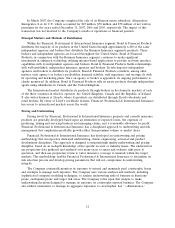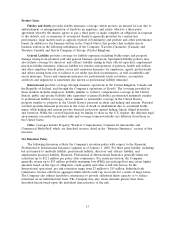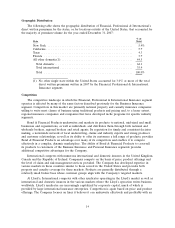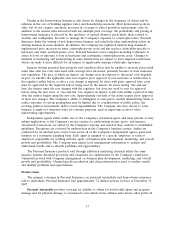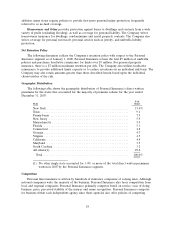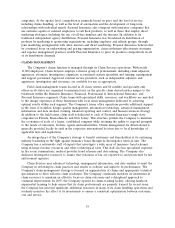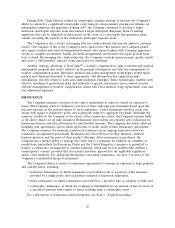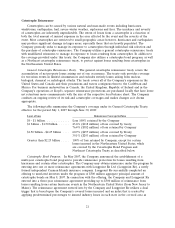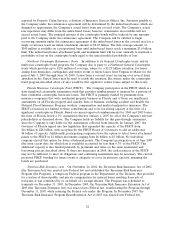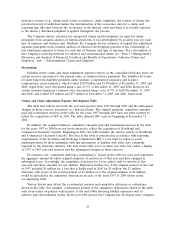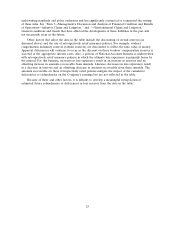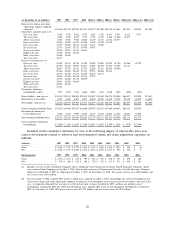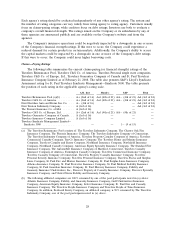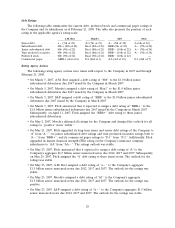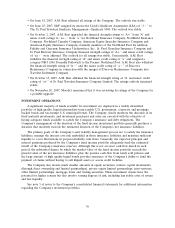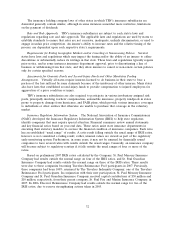Travelers 2007 Annual Report Download - page 34
Download and view the complete annual report
Please find page 34 of the 2007 Travelers annual report below. You can navigate through the pages in the report by either clicking on the pages listed below, or by using the keyword search tool below to find specific information within the annual report.reported by Property Claim Services, a division of Insurance Services Offices, Inc. Amounts payable to
the Company under the reinsurance agreement will be determined by the index-based losses, which are
designed to approximate the Company’s actual losses from any covered event. The Company’s actual
loss experience may differ from the index-based losses; however, reinsurance recoverables will not
exceed actual losses. The principal amount of the catastrophe bonds will be reduced by any amounts
paid to the Company under the reinsurance agreement. The Company will be entitled to begin
recovering amounts under the reinsurance agreement if the index-based losses in the covered area for a
single occurrence reach an initial attachment amount of $2.25 billion. The full coverage amount of
$500 million is available on a proportional basis until index-based losses reach a maximum $3.0 billion
limit. The index-based losses attachment point and maximum limit will be reset annually to maintain a
probability of loss on the catastrophe bonds equal to the initial modeled probability of loss.
Northeast Catastrophe Reinsurance Treaty. In addition to its General Catastrophe treaty and its
multi-year catastrophe bond program, the Company also is party to a Northeast General Catastrophe
treaty which provides up to $250 million of coverage, subject to a $2.25 billion retention, for losses
arising from hurricanes, earthquakes and winter storm or freeze losses from Virginia to Maine for the
period July 1, 2007 through June 30, 2008. Losses from a covered event (occurring over several days)
anywhere in the United States may be used to satisfy the retention. Recoveries under the catastrophe
bond program described above (if any) would be first applied to reduce losses subject to this treaty.
Florida Hurricane Catastrophe Fund (FHCF). The Company participates in the FHCF, which is a
state-mandated catastrophe reinsurance fund that provides reimbursement to insurers for a portion of
their residential catastrophic hurricane losses. The FHCF is primarily funded by premiums from
insurance companies that write residential property business in Florida and, if those are insufficient,
assessments on all Florida property and casualty lines of business, excluding accident and health, the
National Flood Insurance Program, workers’ compensation and medical malpractice insurance. The
FHCF’s resources are limited to these contributions and to its borrowing capacity at the time of a
significant catastrophe in Florida. Based on current expected reimbursements for 2004 and 2005 losses,
the state of Florida levied a 1% assessment effective January 1, 2007 for all of the Company’s relevant
policyholders as discussed above. The Company holds no liability for this pass-through assessment,
since the Company is only liable for the assessments collected from insureds. In January 2007, the
Governor of Florida signed into law legislation that expanded the capacity of the FHCF from
$16 billion to $28 billion, with an option for the FHCF Board of Governors to add an additional
$4 billion of capacity. Additionally, participating companies have the option to select lower attachment
points to the FHCF in $1 billion increments ranging from $6 billion to $3 billion. No individual
company elected this option for lower attachment points. The Company’s participation as of June 2007
(the most recent date for which data is available) accounted for less than 0.7% of the FHCF. This
additional capacity is also funded primarily by premiums and relies on the same assessment and
borrowing process described above. If there are hurricanes in 2008, the cash resources of the FHCF
may not be sufficient to meet its obligations and continuing assessments may be necessary. The current
projected FHCF bonding for future events is adequate to cover its statutory capacity, assuming the
bonds are purchased.
Terrorism Risk Insurance Acts. On November 26, 2002, the Terrorism Risk Insurance Act of 2002
(the Terrorism Act) was enacted into Federal law and established the Terrorism Risk Insurance
Program (the Program), a temporary Federal program in the Department of the Treasury, that provided
for a system of shared public and private compensation for insured losses resulting from acts of
terrorism or war committed by or on behalf of a foreign interest. The Program was scheduled to
terminate on December 31, 2005. In December 2005, the Terrorism Risk Insurance Extension Act of
2005 (the Terrorism Extension Act) was enacted into Federal law, reauthorizing the Program through
December 31, 2007, while reducing the Federal role under the Program. In December 2007, the
Terrorism Risk Insurance Program Reauthorization Act of 2007 was enacted into Federal law,
22


